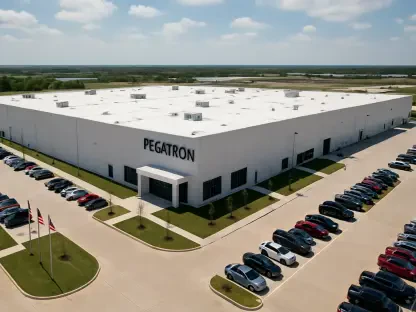The launch of a new line of compact electric delivery vans by a leading automotive manufacturer marks a significant milestone in the pursuit of revolutionizing last-mile logistics and urban transportation. Unveiled at a high-profile event, these electric vans are adorned with eco-friendly features and cutting-edge technological advancements. Attendees at the event, including key executives from the manufacturing company, environmental advocates, and industry insiders, signaled a robust commitment to embracing sustainable urban transport solutions. This move is poised to address the growing need for environmentally conscious logistics and reduce the carbon footprint in urban areas.
Commitment to Eco-Friendly Solutions
Unveiling of Next-Gen Technological Features
The recent unveiling event for the compact electric delivery vans highlighted several features designed to enhance safety and efficiency in urban delivery services. Among the key technological advancements integrated into these vans are Advanced Driver Assist Systems (ADAS), which augment driver control and help prevent accidents by offering features like lane-keeping assistance, adaptive cruise control, and emergency braking. These systems aim to make urban driving less strenuous and more secure for delivery personnel. Furthermore, these electric vans come with rapid charging capabilities, significantly reducing operational downtime and ensuring that the vehicles are more frequently on the road, rather than waiting to be recharged.
Another notable feature introduced in these vans is their compact design, which enhances maneuverability. This is especially crucial for last-mile deliveries in densely populated urban centers where navigating narrow and crowded streets can be a challenge. The compact size does not compromise on payload capacity, as the designers have skillfully maximized interior space to accommodate commercial delivery needs. Combined with their zero tailpipe emissions, these vans help improve overall air quality in cities, contributing to a healthier environment for urban residents.
Key Executives Envision Future of Urban Logistics
During the launch event, key executives, including the Managing Director and CEO of the manufacturing company, emphasized the strategic importance of this new line of electric delivery vans. Their speeches reflected a commitment to sustainable urban transport solutions, stressing the necessity of such eco-friendly vehicles in today’s growing logistics sector. In attendance were also prominent environmental advocates who lent their support, acknowledging the pivotal role of electric vehicles in combating urban pollution and reducing greenhouse gas emissions.
The collaboration between the automotive manufacturer and environmental groups signifies an integrated approach to addressing climate change and urban air quality issues. By investing heavily in electric vehicle technology and forging alliances with environmental stakeholders, the company aims to set a new standard in urban delivery services. This is not just about rolling out a new product; it reflects a vision for the future of logistics and transportation. The manufacturing company’s executives underscored the importance of continuous innovation and investment in green technology, ensuring that urban mobility keeps pace with the demands of a rapidly changing world.
Economic and Environmental Advantages
Cost Efficiency and Environmental Benefits
The newly introduced electric delivery vans offer several notable advantages that could make them a game-changer in urban logistics. One of the primary benefits is cost savings over time; electric vans typically incur lower fuel costs and require less maintenance compared to their gasoline or diesel-powered counterparts. Since electric motors have fewer moving parts than internal combustion engines, the wear and tear is considerably reduced, extending the lifespan of these vehicles and lowering the long-term operational costs for businesses.
In addition to cost efficiency, these vans emit zero tailpipe emissions. This quality aligns perfectly with the broader environmental goals of reducing air pollution and minimizing the urban carbon footprint. The absence of emissions contributes to improved air quality in cities, which can have widespread public health benefits. Moreover, the quieter operation of electric vehicles helps to significantly reduce noise pollution, creating a more pleasant and less disruptive urban environment. These environmental advantages not only benefit the residents but also enhance the company’s reputation as a leader in sustainable business practices.
Challenges of Infrastructure Readiness
Despite the promising advantages, the rollout of electric delivery vans faces several significant challenges, primarily related to infrastructure readiness. One of the most substantial hurdles is the availability of charging stations, which is crucial for the daily operations of electric vans. Urban areas must be equipped with a sufficient number of public and private charging points to support the increasing number of electric vehicles on the road. Without an adequate charging infrastructure, the efficiency and practicality of deploying these electric vans at scale could be severely hampered.
Another layer to the infrastructure challenge is the capacity of the electrical grid to handle the additional load from the widespread adoption of electric vehicles. For seamless integration, the grid must be upgraded to accommodate the increased demand for electricity. This involves not just enhancements in power generation but also substantial investments in the transmission and distribution networks to ensure reliable service. Addressing these infrastructure concerns is essential to realizing the full potential of electric delivery vans and ensuring a smooth transition from traditional fuel-based vehicles.
Pros and Cons of New Electric Vans
Addressing Carbon Footprint and Noise Pollution
The introduction of electric delivery vans is a substantial step toward reducing the urban carbon footprint. By eliminating tailpipe emissions, these vehicles directly address one of the most pressing environmental issues in cities: air quality. Compared to traditional delivery vans that burn gasoline or diesel, electric vans contribute significantly to lowering the levels of harmful pollutants like nitrogen oxides and particulate matter, which are often linked to respiratory and cardiovascular diseases. Additionally, the quieter operation of electric vans reduces noise pollution, making urban areas more livable and reducing stress for residents.
However, it is essential to consider the disadvantages alongside these benefits. One of the primary drawbacks is the higher upfront cost of electric delivery vans. Although long-term operational savings are likely, the initial investment can be a barrier for many businesses, particularly smaller enterprises. Moreover, the dependence on charging infrastructure adds another layer of complexity. In regions where charging stations are scarce, businesses might face logistical challenges in ensuring their fleets are adequately powered.
Limitations in Driving Range and Battery Disposal Issues
The introduction of a new line of compact electric delivery vans by a top automotive manufacturer marks a pivotal moment in transforming last-mile logistics and urban transportation. Revealed at a prominent event, these electric vans boast eco-friendly features and state-of-the-art technology. The event attracted key company executives, environmental advocates, and industry experts, clearly demonstrating a strong commitment to sustainable urban transport solutions. This strategic move aims to address the increasing demand for environmentally conscious logistics and significantly reduce the carbon footprint in urban settings. The manufacturers have highlighted the importance of these electric vans in promoting cleaner cities. By incorporating electric powertrains and advanced energy-efficient systems, the new models are set to offer a viable alternative to traditional gas-powered delivery vehicles. These vehicles are equipped with innovative technology that enhances performance and efficiency while minimizing environmental impact. This introduction not only signifies a leap forward in automotive technology but also underscores a growing awareness of environmental responsibility within the industry.









